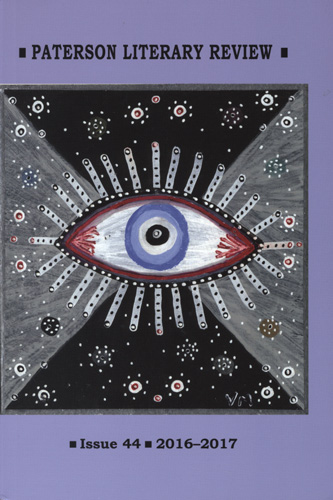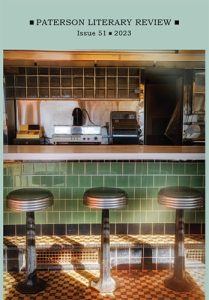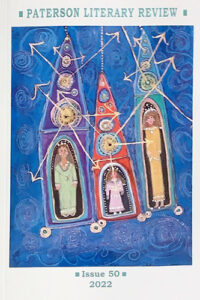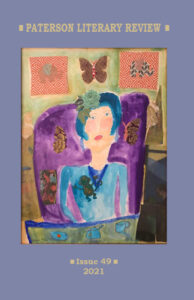Paterson Literary Review – 2016-2017
It is no surprise that the Paterson Literary Review was named the best journal in 2008, and has been in publication since 1979. The journal shares the talents of many amazing poets, prose writers, reviewers, interviewers, and memoir authors. I particularly liked how the poetry section often provides more than one poem from each poet so that the reader can experience a variety of work from each poet. In addition, this issue includes the poems from the 2015 Allen Ginsberg Poetry Awards.
It is no surprise that the Paterson Literary Review was named the best journal in 2008, and has been in publication since 1979. The journal shares the talents of many amazing poets, prose writers, reviewers, interviewers, and memoir authors. I particularly liked how the poetry section often provides more than one poem from each poet so that the reader can experience a variety of work from each poet. In addition, this issue includes the poems from the 2015 Allen Ginsberg Poetry Awards.
One poem that truly hit home for me was “Greg’s Poem” by Daniel Donaghy. This poem tells the story of Gregory Loper who was killed in a hit and run accident in 2011. It tells the story of his life, how “he meets the woman / who’ll make him quit // gangbanging after four shots” and how his wife was left to “cradle the side mirror / of the car that killed him // to keep close the last thing / that touched him alive.” This poem showed me the pain and the anguish of the family and neighbors who lost Gregory because a repeat offender, arrested for a DUI the day before, was still on the road to take this man away from his family.
“The Hoodies Tale” by Jaimee Wriston Colbert also tells a gut wrenching, heartfelt story of loss about a girl who disappears and a mother who never learns what happened to her or where she went. The mother is left only with the girl’s hoodie, “Its pockets filled with her innocence,” which had been tossed out by the boy she was last with, afraid he would be blamed for her disappearance. In this story, I felt as if I could experience the mother’s feelings in the face of this incomprehensible loss while she struggles to move past it, still clinging to some hope that her daughter may come back.
One of the first-place poems for the 2015 Allen Ginsberg Award, “The Young Suicide’s World Atlas,” by C.J. Southworth, we struck me as incredibly powerful, bringing to light the experiences and the aftermath of a young person who committed suicide. We see the story of a young person who contemplates suicide. He or she finally decide to commit suicide in a classmate’s bathroom “because you thought it would be easier / for your parents not to find you / for your mother not to have to scrub the crimson ring / from around the tub.” With this poem, I am reminded of the people left behind to deal with suicide, exchanging a “single plot of mourning [ . . . ] for a child they had hoped to give the whole world.” The devastation, the loss, the unnecessariness of it all—everything I have always felt at the thought of suicide—are present here, in this well-written poem.
Poems and stories of nostalgia are a common theme in this issue, such as in “Mother’s Snuggies” by Elizabeth Marchitti, an Editor’s Choice poem for the 2015 Allen Ginsberg Award. The poet shares the story of her mother who loved to wear “snuggies” under her woolen skirts to church. The daughter notes that these are not easy to find in modern days, but she found and bought them so that:
my mother could be warm
on a cold winter Sunday,
when I drove us to church,
me in my warm velour slacks
Mother in her snuggies.
It reminds me of all the little things my mother loves that I struggle to find for her every year—because “Once you are old, the world forgets / that you need things you were used to.” It is the little things that make us feel comfortable, particularly in old age.
Along these same themes, a short story in this issue, “The Wrong Old Lady” by Sophia Eve Capotorto-Weiss tells how she struggles to connect with a grandmother who was “movie star beautiful.” The author spends most of the story following around a random old lady, picturing how it would be like with this person as her grandmother, what she would smell like, what her home would be like, and how “This is the cookies n’ cream Grandmother that I never had.” She longs for a sense of intimacy with her own grandmother that had been lost, reminding us why we must seek ways to treasure our family, to connect with them so that we are not aimlessly wishing for a relationship we do not have.
Even amidst the stories of memory, of sadness, of love lost or forgotten, of family members remembered, now gone in this issue of Paterson Literary Review, there is a beautiful poem, “Sister Dear” by Susan Holmes. Here, she recalls the antics of her and her older sister throughout the years. In the end, she shares:
Over time,
We met love and death,
Illness, recovery, heartbreak and joy
TogetherBut now is our best time
Retired
Kayaking in the placid waters of the Swift River
Appreciating the nearness of nature
And our closeness to each other.
This poem resonated with me, as I am an older sister and have experienced so many of these activities with my own sister. I hope in our old age, retired, we too can be like this woman and her sister—appreciating each other, nature, and the long, beautiful, turbulent past we left behind together.
Beyond just poems and short stories, this issue includes reviews, interviews, and even memoirs. The variety of work provides a little bit for all tastes, and it is clear from what I saw in this issue that the Paterson Literary Review is a must-have literary magazine for people with diverse reading tastes.
[www.patersonliteraryreview.com]





